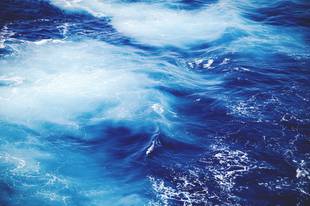
Characteristics of the Ocean
Of course, not all of the earth’s land area is dry. We are all aware that the earth is made up of a greater part of water, particularly the ocean. The oceans occupy 70.8% of the surface area of the earth or that is 360 million square kilometre, leaving less than a third of the earth’s surface area for continents. The total volume of all the oceans is 1.4 billion cubic kilometre. The major sub-divisions of the oceans are the Pacific, the Atlantic, the Indian and the Arctic oceans. Of these four oceans, the Pacific ocean is the largest and the deepest. It occupies almost one third of the earth’s total area. It has an area of 70 million square miles.
The oceans are salty and salt is a common mineral on the earth. The amount of salt dissolved in the oceans is, on the average, 34.5% by weight. When water evaporates from the oceans into the atmosphere, the salt is left behind. In addition to its major chemical constituents, seawater also contains trace amounts of all the other elements. These nutrients include such substances as nitrate, phosphate, iron and manganese. In fact, of the 90 naturally occurring elements, 85 of these is found in seawater. The most abundant elements are hydrogen and oxygen.
The earth’s ocean has an average depth of 12,000 feet. The deepest known spot is the Marianas Trench in the western Pacific Ocean, near the island of Guam. It lies 36,198 ft below sea level.
The surface temperature of the ocean varies from about -2 c near the north and south poles to about 30 C near the equator. Below the surface waters, the temperature drops rapidly, forming a layer called the thermocline.
The Structure Of The Ocean
How does the ocean look like? Many methods exist for exploring and mapping ocean depths. The tidal zone or shoreline is the region where the land and sea meet. The ocean has continental margins – the area where the under water edge of the continents meet the ocean floor. This forms the part of the seabed that borders the continents. It consist of continental shelf, continental slope, the continental rise and the ocean floor.
The continental shelf is the seaward, where the land drops downward underwater to depths as great as 500 to 600 feet. It is the relatively flat part of a continental margin that is covered by shallow ocean water. The continental shelf is the submerged land at the edge of the continents. It is widest where is has been formed from the deposits of mud and silt carried from the interior of the continents by rivers or from the gradual sinking of land itself. Where the land has eroded from the non-stop battering of waves against the shore, the continent shelf is shallow. The shelf may project for 100-800 miles. In some cases, where mountain ranges rise along the coastline, there may be no shelf.
The continental slope marks the boundary between continental crust and ocean floor. It begins at the outer edge of the shelf. These slopes are the farthest boundaries of the continents. They plunge two miles or more to the deep-sea floor.
The continental rise separates the continental slope from ocean floor. It consists of sediments from continental shelf and slopes that accumulates at the bottom of slope.
The final zone is the ocean basins or floor. The large flat area on the ocean floor is the abyssal plains. There are two major provinces of ocean basins: the mid-oceanic ridges and the deep ocean basin. The mid-oceanic ridge is by far the greatest submarine mountain ridge in the world. It is a continuous 40,000-mile belt that encircles the world and bisects the oceans. It is up to 1,000 miles wide.
Other structures found on the ocean floor includes trenches, guyots, and canyons. Deep fracture zones and trenches carve the ocean bottom. There are also submarine mountain ranges, long ridges, and volcanic peaks, the highest points of which may rise above the water as oceanic islands. Mauana Kea which is 13,796 ft above sea level is Hawaii’s highest volcanic peak. From its volcanoes in the ocean floor.
The Importance of the Ocean
As a wealth of resources, the ocean provides many major resources. They include food, energy, minerals and medicines. People are increasingly farming the ocean. With their abundance of plant and animal life, the oceans offer much potential as a source of food for humans. Energy from the ocean has several forms. Solar energy is an inexhaustible resource absorbed by oceans. The heat, which is also a form of energy is transmitted during absorption and is responsible for ocean waves, difference in water and air temperature and currents. There are so many minerals found in the ocean. Minerals recovered from the ocean include sand and gravel used for construction materials, gold, tin, iron, diamonds and much more. From many forms of marine life are produced various medicinal products.
The oceans also influence the climate. Water has as high capacity for strong heat. It warns more slowly than land and also cools more slowly. Thus the coasts of the continents have cooler summers and warmer winters than the inland areas. Storms are formed from oceans making the oceans birthplace of storms.

















